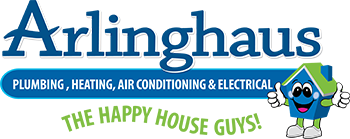Take a deep breath. Does it feel good, or do you have to take a break to cough? You would be surprised how much your home’s air quality can affect your health in little ways like this. Fortunately, there are a number of easy steps you can take to clean up your air and make your home’s systems work better to keep you breathing clear.
What Is Indoor Air Quality?
For a really simple object lesson to explain indoor air quality, imagine cooking a really odoriferous meal in the kitchen with lots of garlic, onions, maybe fish. The scent lasts for hours and seems to permeate the whole house. Or, you might recall the last time you closed the door on a stinky bathroom or bedroom and opened it hours later, only to discover that the stench is still there. Like these unpleasant smells, your indoor air quality relates to all kinds of airborne contaminants that move throughout your home. You may be able to see them, but most of them are beyond your sight. You can breathe them in, and like the smell of mold, they could cause all manner of havoc in your life.
How Does Indoor Air Quality Relate to Outdoor Air Quality?
Do not let the pollen in the crisp, fall air fool you. For years now, researchers have argued that indoor air quality affects your health much more than the air outside. Why is this? There are a couple of reasons. First, people spend as much as 90 percent of their time indoors, particularly as the weather gets colder. Second, most of the contaminants that aggravate chronic conditions like allergies and asthma can be brought indoors by a wide variety of paths. This underscores the importance of making sure that outdoor contaminants do not make tracks through your home, and that the air you breathe inside is safe.
Why Does Indoor Air Quality Matter?
Indoor air quality can seem like the buzzword of the day designed to make you buy expensive equipment, but the truth is much more nuanced. Chances are, someone in your household suffers from seasonal allergies. In fact, the Asthma and Allergy Foundation of America ranks Louisville, KY as the #1 city in the country for fall allergies. The city also consistently ranks in the top five for spring allergies, as well. Ragweed is the allergen most likely to cause you misery as you head toward harvest season, but you might also suffer from exposure to mold that started growing in the spring. These pollutants can cause the following symptoms:
- stuffy nose
- persistent, dry cough
- chest congestion
- headaches
If you experience any of these, you could probably stand to improve your indoor air quality, to prevent them from getting worse, and improved indoor air quality can also raise your property value.
Tip #1: Control Pollutants at the Source
As you know from the kitchen odors and smelly bathroom object lesson, there are plenty of contaminants that start and stay inside your home. Your goal is to locate and neutralize them. You would never clean a bathroom using ammonia or bleach with the doors closed, because you know that the fumes may affect your ability to breathe. Harsh cleansers and some household goods like paint or chemical solvents emit vapors that decrease your indoor air quality. You might be able to eliminate some of them from your home entirely, by switching to simple, natural cleansers (e.g. baking soda and vinegar). For the solutions you cannot replace, find a good place to store them where you spend less time, such as your garage. Wherever you move them, be sure to keep them out of the reach of children or pets.
Tip #2: Stop Outdoor Air Quality From Ruining Your Home
The next step is to prevent all of the outdoor allergens from constantly crashing your house party. Your home’s ventilation is beautifully designed to draw contaminants out of the home, as well as filtering the air as it enters your home. There are a few notes to consider about this truth:
- Your ventilation system is only as good as it is maintained
- The equipment must be used to be effective
- There are other ways for contaminants to enter the home
To have any chance, you have to keep your home’s ventilation in excellent working order. Request service for your HVAC system for the fall. Fall maintenance includes the inspection and replacement of your air filter, which is the most effective barrier between the outdoor air and your home. An HVAC expert can also check your furnace emissions and ventilation to make sure that you are not facing a deadly buildup of carbon monoxide in the home. Service in the fall is a minor investment that protects your HVAC equipment and keeps the heat running all winter long.
In order for your ventilation and HVAC equipment to help improve your indoor air quality, you have to use it regularly. As the air gets cooler, you might decide to leave the air conditioner off.
However, you need the system’s ventilation to remove pollutants. If you have a gas stove, be sure to turn on the fan on every time to pull the gas fumes outside. Use the bathroom fans during each shower or bath. Your HVAC system removes some humidity out of your home, which limits the growth of mold and keeps you feeling generally more comfortable. You may need an additional dehumidifier to adequately dry the air in certain rooms.
As you open your windows wide to get a little of that fall fresh air, you realize that the space is an open door for allergens. There is not necessarily a great deal of risk posed to you by opening the windows every now and then, but you want to make sure that your windows and doors are not letting in the dust and allergens 24/7. Seal the spaces around your windows and doors with caulking and weather-stripping, to stop the air leaks that compromise your air quality.
Tip #3: Kick Filtration Up a Notch
For many people, these first two steps may be all they need. For others, it is simply not enough. It is up to you to decide if you need to improve the filtration in your home, based on your family’s health and the contaminants you encounter on your property. Ask your HVAC technician if the Minimum Efficient Reporting Value (MERV) rating of your air filter could be increased. Most people do not need air filters with the highest MERV ratings. However, you may benefit from using an air filter that is designed to remove finer pieces of particulate matter. You can also use a vacuum with HEPA filtration, which may eliminate more allergens.
There are a number of air purifiers on the market that claim to significantly improve your indoor air quality. You should bear in mind that most of these products are built to remove particles, not gaseous pollutants. Some are able to get rid of smoke from the air, as well as dust or pollen. You can select from portable models and systems that filter the air in your entire home. Be sure to shop around and get recommendations for the best choices, because some products are virtually ineffective at removing contaminants from the air.
Perhaps not surprisingly, one of the best ways to easily improve your indoor air quality is to add a little greenery. Certain types of plants are better than others at removing pollutants and replacing them with fresh air. Keeping a spider plant, aloe or azaleas could eliminate formaldehyde in your home, which commonly comes from insulation and plywood. Just avoid watering them too much, to avoid growing fungi that could increase your family’s allergy symptoms.
Breathe Easier this Fall
You want to live in a home that feels fresh and clear, like a bright autumn morning. With these three tips, you can get rid of the pollutants in your air and leave nothing behind but the scent of fall leaves.
For more ways to improve your indoor air quality and choose the best air purifier for your home, check out our article.


